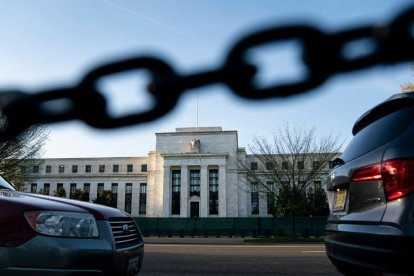In the red: The U.S. went $1.2 trillion more in debt in the last eight months
This was estimated in a report from the Congressional Budget Office (CBO), a nonpartisan organization that has been preparing budget analyses since 1975.

Cordon Press
The United States borrowed $1.2 trillion in the last eight months, according to a report from the Congressional Budget Office (CBO), a nonpartisan organization that has been preparing budget analyses since 1975.
According to the document, the figure is about $38 billion above the budgeted deficit recorded during the same period of fiscal year 2023.
Looking at data collected by the CBO, spending on social programs such as Social Security, Medicare and Medicaid increased 6% over the past eight months, which is equivalent to a nominal increase of $117 billion.
Among the three, Medicare saw the largest increase, 10%, or $51 billion, due to "increased benefit payments to Medicare Advantage plans."
"Total outlays were up 8 percent in the past eight months, reaching $4.5 trillion, as the CBO noted a 42 percent increase in net outlays for interest on the public debt. The percentage represents an estimated $185 billion increase over the same period in fiscal 2023; the office pointed to rising interest rates as a key contributor," The Hill explained regarding the report.
Indeed, the United Nations (UN) prepared a recent report entitled 'A World of Debt.' The United States led the world ranking of public debt with more than $33 trillion in debt. China took second place with almost $15 billion, and Japan completed the podium with $10.6 billion.
The danger of public debt
“I place economy among the first and most important virtues, and public debt as the greatest of dangers to be feared. To preserve our independence, we must not let our rulers load us with perpetual debt," said Thomas Jefferson many years ago, as a warning for the present and future.
However, the former president would not be very happy with the recent data on the national debt, that is, what the United States owes its creditors. The figure was released at the end of February and was somewhere between alarming and catastrophic. According to the Treasury Department, the number amounts to $34,332,006,626,320.48.
The number is even more shocking when compared to what the United States owed about 40 years ago when the national debt was $907 billion.
The Congressional Budget Office is not very hopeful regarding the future. It estimates that the national debt will grow to $54 trillion in the next decade, due in part to an aging population and federal health care costs. Even higher interest rates are also aggravating the fiscal situation.
If you calculate the debt per capita, that is, what corresponds to each inhabitant for the debt contracted by the government, each American would owe $103,409.
RECOMMENDATION





















